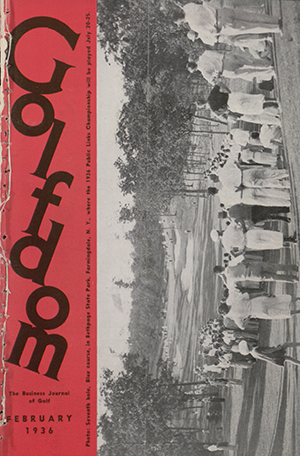The Golfdom Files: The latest on sodium chlorate
Golfdom Science Editor Clark Throssell, Ph.D., does an outstanding job collecting the industry’s latest research for the Super Science section. More than 80 years ago, Penn State Extension Agronomist Fred Grau, Ph.D., played a similar role for the magazine.
Grau originally provided readers with research on how to control crabgrass with sodium chlorate in the April 1934 Golfdom. In the February 1936 edition, Grau wrote an update on that cultural practice based on new developments in university research.
The research Grau presents is dated today, but it’s still important to understand how far the research has come, and it’s interesting to think about where we could be 80 years from now.
 Since Golfdom in April 1934 published the first article on the control of crabgrass with sodium chlorate, there have been some additional developments. The time and the number of applications, however, are somewhat different, resulting in a great advantage in the saving of time, materials and labor…
Since Golfdom in April 1934 published the first article on the control of crabgrass with sodium chlorate, there have been some additional developments. The time and the number of applications, however, are somewhat different, resulting in a great advantage in the saving of time, materials and labor…
We have learned that the food reserves of a plant are at low ebb during the seed-producing period, indicating that this period marks a weak point in the life history of the plant. This fact has been made use of in the chemical and cultural control of many farm weeds. Applied at the right time, sodium chlorate destroys the chloroplasts and starch grains and effectively prevents the formation of viable seed. In a plant, which reproduces only by seeds, the destruction of a year’s seed crop would greatly diminish the infestation in the succeeding year.
With this thought in mind, and, due to the ever-present crabgrass menace in turf, a number of demonstrations were conducted in 1935 on lawn and athletic field turf in and around Philadelphia in cooperation with Pennsylvania State College. Briefly, procedure was as follows:
A single application was made to crabgrass-infested areas at the time when the seed panicles were beginning to burst forth from the sheath (usually during July and early August) before the flowers had opened or had a chance to pollinate. Two to 2 1/2 lbs. of sugar-fine sodium chlorate were thoroughly mixed with a 12- to 14-quart pail full of screened dry soil or sand, and uniformly broadcast on 1,000 sq. ft. Water was applied as a spray to dissolve the chemical so that it would be more quickly absorbed by the plants. In some cases, no water was needed due to timely rainfall and a soil that was well supplied with moisture.
Report 100 percent kill
In every case, this simple operation accomplished the desired results. No crabgrass seeds matured, and there was virtually 100 percent kill. The bluegrass was temporarily injured, but within two weeks it was green and growing well. The operation was a success and the patient recovered. But, a convalescent patient cannot grow strong and healthy without food, and it is a well-known fact that much of the turf in the East is poor because of a lack of fertility.
Three to four weeks after the chlorate treatment, the dead crabgrass was removed with rakes and the surface soil was lightly scarified. An application of complete fertilizer was made, a little seed scattered in the thin spots where the crabgrass had smothered everything, and the area was lightly rolled and then watered.
About Oct. 1, eight weeks after the initial application, the treated areas presented a desirable dense green cover of turf whereas the untreated areas were dull, dead and brown, typical of dead crabgrass.
Factors to watch
The success of this simple treatment of crabgrass is dependent upon several things:
- Making the initial application just as the seedheads break from the sheath
- Uniform distribution of the chemical
- Ample supply of soil moisture
- Subsequent fertilization and seeding of thin places to encourage a dense sod of grass, and sound maintenance practices to prevent further invasion of crabgrass
Photo: Golfdom








